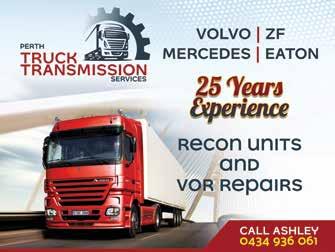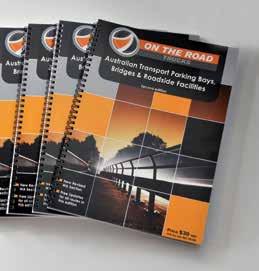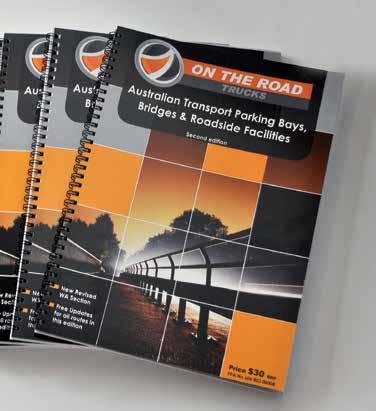
4 minute read
WA Transport History
The History of the West Australian Road Transport Industry
St Georges Terrace, 1968
Advertisement

1968
Urged on by the Transport Advisory Council, the Government agrees to lift all operational controls on general road transport in the north of the State, beyond railheads at Geraldton and Meekatharra.
Secretary W R Pellew reported to the March 27 Executive Council meeting on a recent visit to Kulin where he met with livestock carriers and where rates were adopted for livestock cartage.
It was reported to the April 18 Executive Council meeting that due to the action taken by the Transport Advisory Council, annual licences were now available for road transport operations north of the railheads at Meekatharra and Geraldton.
Also reported to the same meeting was that Eneabba district farmers were being compelled to purchase trucks to transport their requirements and produce, mainly due to the fact that the railroad route involved a 400km haul whereas direct road transport could be achieved within 240km. In addition, the existing regulations precluded the usage of professional carriers.
The Government commissioned a survey of transport costs north of the 26th Parallel, whose findings confirmed that high freight rates for general cargoes could only be reduced by operating much bigger road vehicles than those already in use. As a result, the Director General of Transport, John Knox, established a study group to investigate, among other alternatives, the possibility of using triplebottom vehicles, initially on the 900km stretch of the Great Northern
By Russell McKinnon
Highway, which ran along the eastern fringe of the Pilbara between Meekatharra and Port Hedland. Triple bottom was the official description of a road train consisting of two trailers, hauled either by a massive truck or by a prime mover with a semi-trailer of equal size. Bill Roots was appointed from WARTA with his 32 years’ varied and comprehensive experience. The group toured the North-West and Northern Territory, sometimes by truck, and presented what was known as the Salter report, after retired State Police Commissioner R C Salter, who headed the group.
By the time the group was established, freight cargoes into remote areas of the State were already expanding considerably. They included 150,000 tonnes of general cargo annually for areas north of Carnarvon, as well as 500,000 tonnes of livestock, ore and minerals sent by road to the North-West ports or railheads. Goldfields ore and concentrates roaded to the Kalgoorlie railhead totalled 650,000 tonnes annually. The combined annual total of road cargoes had reached more than four million tonnes and is expected to increase by more than 10 percent per year.
Transport and Shipping Division Chairman W Roots put his seat up for grabs when he announced at the May 2 Meeting that he had changed employers from Mayne Nickless Ltd to Sweeny United Transport. He was confirmed in the position.
The May 2 Meeting of the Transport and Shipping Division heard that there was a severe shortage of parts for Ford, International and Bedford vehicles.
The Transport and Shipping Division Annual General Meeting of June 27 took the unusual step of electing two chairmen, with C Love and W Roots alternating in the Chair.
The ARTF reported that a technical committee appointed by the Australian Rubber Manufacturers’ Association has recommended the replacement of truck tyres if the tread pattern does not have a depth of 1.58mm throughout at least 75 percent of the tread width around the tyre circumference.
At the Annual General Meeting of August 8, President F A Manford highlighted the happenings of the past year: • Government controls and the Transport Advisory Council; • Publications issued by the Association to its members; • Branch activities; • Australian Road Transport Federation activities; • The importance of school bus services throughout the State; • Association membership drive.
It was reported to the Annual General Meeting that the Police Traffic Department was taking action against truck owners where palletised cargo was being loaded on trucks resulting in widths, which exceeded the allowable limit of 8ft 2 ½ inches, in the old measurement.
ASSOCIATIONS
LIVESTOCK AND RURAL TRANSPORT ASSOCIATION OF WA
THE VOICE OF WA RURAL TRANSPORT SINCE 1980 - PROMOTING SAFETY, PRODUCTIVITY & EFFICIENCY
Membership Enquiries T: 08 9478 3655

REPAIRS
TYRE EQUIPMENT AUSTRALIA
YOUR ONE STOP TYRE EQUIPMENT SUPPLIER

TRUCK TYRE CHANGER
18/9 Inspiration Drive Wangara WA 6065 PHONE: NEVILLE BAKER 0419 515 151 www.tyreequipment.com.au sales@tyreequipment.com.au YOUR SPACE This space could be your spot to reach over 12,000 readers in the Western Australian transport and associated sectors.
Contact Karen at Karen@angrychicken.com.au or Ph 08 9296 4488
ON THE ROAD TRUCKS
The ‘must have’ book for transport Now available in operators giving you the locations DIGITAL format $30 (distances) of Transport Parking The ‘must have’ publication for anyone in the transport industry requiring Bays, Bridge information, roadside the locations (distances) of transport parking bays, bridge information, facilities and their services roadhouses and their facilities and dirt tracks suitable for parking throughout throughout mainland regional mainland Australia. Australia. PRINT or use on your TABLET
HARD COPIES NOW AVAILABLE ~


$40 EACH
Hurry Limited copies left On the Road - Trucks is now available in high resolution PDF format which means you can use it on your Only $30 plus postage TO ORDER Having trouble finding space in rest areas? WA GRAVEL TRACKS in this edition TABLET as well as print it. You will be sent an invoice with EFT details, and once payment is received the book (6mb) will be emailed to you. To order: Email this form to karen@angrychicken.com.au visit www.angrychicken.com.au karen@angrychicken.com.au • Ph 08 9296 4488Name........................................................................................................................................................................................Company Name ................................................................................................................................................................. Address (for invoice) ..............................................................................................................................................................................................................................................................................................................................................................










